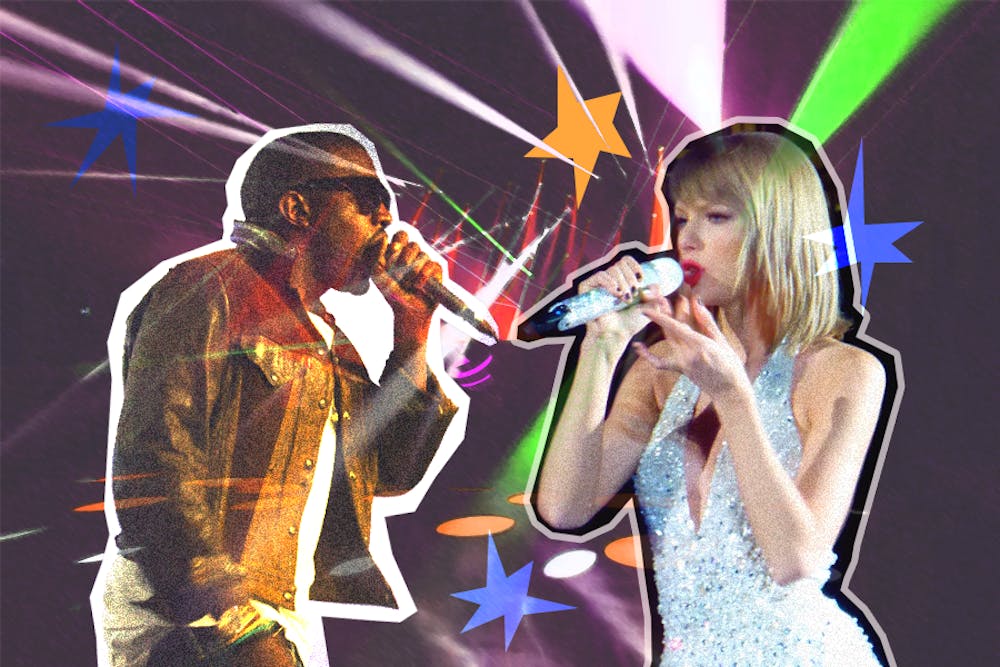Kanye West interrupting Taylor Swift. Lady Gaga wearing a meat dress. Madonna and Britney Spears kissing. Miley Cyrus twerking. These are just a few of the iconic moments from past MTV Video Music Awards. In an award show that celebrates memorable music videos—from Michael Jackson’s “Thriller” to Missy Elliot’s “Work It”—the annual event is a hub for the artistic visionaries of the music industry.
Fast forward to today, and it’s hard to remember who even won last year’s “Video of the Year” award, much less any of the performances. From its peak popularity in the late 1990s and early 2000s, the VMAs are a shell of what they used to be. Thanks to declining cable viewers, clashes of creative control, and an out–of–touch attempt to appeal to younger audiences, the VMAs are losing relevance at an unprecedented rate. Only time will tell if the show can bounce back.
MTV’s woes aren’t entirely their own fault, however. The largest contributing factor to the award show’s decline is the overall drop in cable viewership. Starting in the 1980s, having cable television was a must for every family. MTV capitalized on this audience by playing music videos on their channel 24/7, and soon, MTV became synonymous with the pop culture of the times. Everyone and their moms were familiar with Slim Shady, Janet Jackson, and Spears, and it’s largely thanks to MTV.
Cable TV peaked in the 2010s during the “Golden Age of Television.” Since then, cable shows failed to compete with the rise of streaming networks like Netflix and Hulu. With streaming services being the dominant way people are watching TV nowadays, the VMAs’ declining ratings are part of a larger trend of people cutting the cord in favor of on–demand content and binge–watching.
Yet, the VMAs’ fall from grace is unusual for an event famed for its controversies and attendance from high–profile celebrities. When MTV created the VMAs in 1984, it was during the peak of their “I want my MTV” campaign—when the network marketed itself as a hub for famous musicians like David Bowie, Cyndi Lauper, and later, Black musicians like Michael Jackson. Music videos took American entertainment culture by storm, and the VMAs became a massive annual event, celebrating the Madonnas and Billy Joels of the time.
The network began scaling back on playing music videos in the ‘90s after its involvement with Bill Clinton’s presidential campaign. As the network began focusing more on reality shows, the VMAs remained extremely popular thanks to a string of buzz–worthy and unscripted events, from Madonna giving many provocative performances to Mariah Carey and Whitney Houston’s lookalike dresses that clapped back at rumors of them feuding.
The one thing the network hates, however, is these unscripted events. As the years went by, the network tried to forcibly create many viral–worthy events to generate buzz. You probably don’t remember that Swift sang in the New York City subway in the 2009 iteration of the show, an MTV–sanctioned performance to generate audience hype. Rather, the event was overshadowed by the infamous West interruption scene that same night, something that stan Twitter still talks about today.
One would think a smart network would learn to capitalize on its unfiltered nature, especially with all the extra gossip it can generate. Yet, MTV doubled down on its control–scripting “impromptu” performances like Katy Perry boxing for “Roar” in 2013 or Nick Jonas eating in a restaurant for “Bacon” in 2016, resulting in the predictable format of the show we know today. A few executives trying to guess what the audience will like makes the show predictable and dull. This self–contradictory nature would explain why the show, ultimately, is forgettable by the next week.
What’s worse than forgettable is cringey. In the network’s attempt to stay relevant, they’ve employed tactics that make people want to turn off the screen. The network’s blatant attempts to draw in younger audiences include inviting TikTok stars and using stan Twitter lingo in their promotional content. While the tactic is understandable, the attempt comes off as insincere. Simultaneously, this repels older audiences who have no connection to the younger generation and would be confused why a person named Charli D’Amelio has anything to do with music. The show has lost the respect of the general public, making the VMAs harder to watch as the years pass.
There seems to be some light at the end of the tunnel, though, as the 2022 iteration of the ceremony saw an uptick in ratings compared to 2021. This increase, although small, was the first time in recent years that the VMAs saw a rise in ratings from year–to–year, COVID–19 pandemic shows included. Thanks to appearances from Nicki Minaj, Swift, Bad Bunny, and BLACKPINK, the show managed to get a satisfactory cross–section of demographics and interest—drawing 3.9 million viewers compared to 3.7 million in 2021. While viewers might still blast the show online for being a nightmare to watch, MTV might have finally found a glimpse of hope to save the show from disappearing into oblivion.







